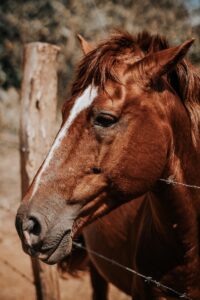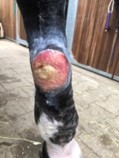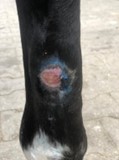Chronic wounds are a common issue in equine medicine. They require special attention, as they can lead to infections, pain, and prolonged healing processes. Therefore, effective and gentle wound care is essential—not only for the horse’s well-being but also for a swift recovery.

Case Study: Metacarpal Wound in a Horse
The documented wound was located craniomedially on the left forelimb’s metacarpus.
- Left/Upper Image: Condition of the lesion immediately after the trauma.
- Right/Lower Image: Wound 10 days after care—significant improvement. The wound is cleaned, its diameter has reduced considerably, the tissue shows regenerative processes, and there are no signs of infection.
Sanocynforte is a modern wound treatment based on stabilized hypochlorous acid (HOCl)—a substance known for its strong antimicrobial effect while being gentle on tissues. It’s ideal for sensitive animal skin and chronic wounds!
Advantages of Sanocynforte in Equine Wound Care:
- Effective reduction of germs (bacteria, fungi, viruses)
- No burning or irritation
- Supports natural wound healing


Sanocynforte vs. Povidone-Iodine, Honey Ointment, and Chlorhexidine
Wound care in horses encompasses a variety of available products—among them, Povidone-Iodine, Honey Ointment, and Chlorhexidine solutions. However, not all are equally suitable.
- Sanocynforte vs. Povidone-Iodine:
- Povidone-Iodine has a strong antimicrobial effect but its efficacy is significantly influenced by the protein and blood content of the wound (strong protein error).
- Sanocynforte is also germicidal but is entirely tissue-friendly, does not sting, and does not stain the skin.
- Ideal for animals with sensitive skin or for prolonged application periods.
- Sanocynforte vs. Honey Ointment (e.g., Manuka Honey):
- Honey ointments support healing through osmotic effect but are often sticky, attract dirt and insects, and are difficult to apply.
- Honey ointments primarily act against bacteria and should not be applied during the granulation phase of wound healing.
- Sanocynforte Hydrogel is easy to apply, clean, does not provide a breeding ground for germs, and can be applied in all phases of wound healing.
- Sanocynforte vs. Chlorhexidine:
- Chlorhexidine is no longer used in human medicine due to a range of undesirable properties.
- Among other things, it is cytotoxic to sensitive tissue—which can hinder healing, especially in chronic wounds. Additionally, it has a strong protein error, and resistance to chlorhexidine is well known!
Sanocynforte: Application in Just 5 Steps
Sanocynforte is a pH-neutral solution for wound cleaning. It is based on a new technology, HOCl (hypochlorous acid), which is harmless to humans and animals, as this acid is also used in natural defense processes. The preservative HOCl in Sanocynforte does not damage healthy tissue and is highly effective in eliminating viruses and bacteria:
Carefully clean affected areas fromdirt to expose the wound.
- Generously spray the affected skin area with Sanocynforte Solution to rinse.
- Allow Sanocynforte Solution to dry for optimal effect.
- Then spray the wound with Sanocynforte Hydrogel. It keeps the wound moist, protects against drying out, and supports tissue regeneration.
- Repeat the application 2–3 times daily.

Conclusion: Rapid Wound Healing in Horses Thanks to Sanocynforte
The case study impressively demonstrates: With the right wound care, even chronic wounds in horses can show significant improvement within a short time. The combination of Sanocynforte Solution and Hydrogel offers a modern, effective, and gentle care option—without irritation or side effects.
